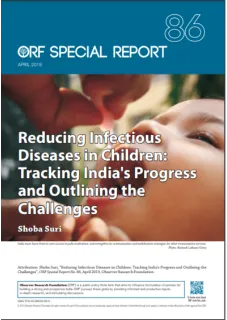Background
In the last two decades, India has made significant progress in improving health indicators, particularly those related to child health. Between 1990 and 2016, under-five mortality in India decreased from 126 to 43 deaths per 1,000 live births. The country was certified polio-free in 2014 and it eliminated maternal and neonatal tetanus in 2015. India’s commitment to improving access to vaccines has been a particularly important intervention in reducing child mortality and morbidity, and immunisation remains a priority amongst decision-makers at the highest levels of government
India first
1introduced the Expanded Programme of Immunization (EPI) in 1978. In 1985, the programme was renamed Universal Immunization Programme (UIP),[v] and is today recognised as the largest such health programme in the world. The Ministry of Health and Family Welfare provides different vaccines to infants, children, and pregnant women via the UIP, making vaccines available free of cost to India’s annual birth cohort of over 27 million children.[vi] However, in 2015-16, the average national full immunisation coverage was a low 62 percent,[vii] with only a few states achieving and sustaining coverage of more than 90 percent. Previously, the percentage increase in full immunisation coverage was one percent per year. This went up to 6.7 percent per year over the first two phases of Mission Indradhanush. Four phases of Mission Indradhanush have been conducted till August 2017, providing vaccination to more than 2.53 crore children and 68 lakh pregnant women. To further boost the programme, Prime Minister Narendra Modi launched the “Intensified Mission Indradhanush” (IMI) in October 2017. Through IMI, the government aims to reach every child up to two years of age and all pregnant women who have been left uncovered under the routine immunisation programme/UIP. The programme provides protection against 12 vaccine-preventable diseases.[ix] The special drive will focus on improving immunisation coverage in select districts and cities to ensure full immunisation coverage of more than 90 percent by 2020, a goal that was then advanced to 2018. Mission Indradhanush has completed four phases covering 528 districts; some 3.19 crore children have been vaccinated. As of September 2018, 1.5 crore doses of the rotavirus vaccine (RVV), eight crore doses of measles rubella (MR) vaccine, and 15 lakh doses of pneumococcal conjugate vaccine (PCV) have been administered to children across the country.
Discussion
According to the Pneumonia and Diarrhea Progress Report 2018, globally, pneumonia and diarrhoea caused 1.36 million deaths in children under five in 2016. Despite significant reductions in disease burdens in recent years with improvements in access to and use of health interventions, nearly half a million pneumonia and diarrhoea deaths were recorded in 2016 in two countries – India and Nigeria. The report reviews progress made by high-burden countries on key indicators including exclusive breastfeeding, immunisation, and access to treatment with ORS, Zinc and appropriate antibiotics.
With an exclusive-breastfeeding rate of 55 percent,vii India already meets the target set by the Integrated Global Action Plan for the Prevention and Control of Pneumonia and Diarrhea. Since access to breastfeeding is not solely dependent on a child’s access to health services, it lends itself more naturally to equitable coverage. In terms of immunisation coverage, however, there is much room for improvement as the full immunisation coverage of universally introduced vaccines remains well below target levels. India has only recently started phased national rollouts of RVV, beginning in 2016, and MR and PCV beginning in 2017, and they have yet to reach all states and union territories. However, the coverage of these remain low even in the states where they have been rolled out. ORS and zinc coverage has improved significantly in the past decade (from 26 percent to 51 percent for ORS and from 0.3 percent to 20 percent for zinc), but still remain below targets.
India’s National Health Mission in 2005 introduced a multi-strategy community intervention known as National Rural Health Mission (NRHM), with facilities such as reimbursing travel to health centers and developing groups of community health activists, to reduce gender inequality, as an approach to improve health equity. This approach has helped reduce inequalities in maternal and child health across geographical areas, socioeconomic status, and gender. It has also led to better uptake in rural areas of services like ORS administration for diarrhoea and immunisation among female children.
According to Dr. Pradeep Halder, DC (Imm-I & UIP-I), Ministry of Health & Family Welfare, Government of India, RVV has been introduced in 11 states to about 50-53 percent of the birth cohort. PCV, introduced in four states fully and partially in Rajasthan and UP, stands at 20-percent coverage and is slated to be scaled up by 10 percent this year. The use of a Mother-Child Protected (MCP) card, which contains messaging on diarrhoea and pneumonia prevention, has been highly effective in aiding in the prevention of new cases of diarrhoea and respiratory infections, as noted by Dr. Pravin H Khobragade, Health Specialist from UNICEF. The challenges, however, remain in terms of availability of the vaccines, capacity building, and training of healthcare providers.
India’s progress in reducing disease burden and increasing coverage of key interventions against pneumonia and diarrhoea
There is adequate evidence that India has made progress in improving access to public health in the last three decades. Mitigating poverty has been important to reducing disease burden; children with already weak immune systems are particularly vulnerable to pneumonia and diarrhoea, putting them at greater risk for further infections. However, India continues to lag behind its many less developed neighbours in vaccination rates, for a range of reasons.
India can substantially reduce pneumonia and diarrhoea deaths through an integrated package of interventions. Exclusive breastfeeding and adequate nutrition help make children healthier and less vulnerable to diseases like pneumonia and diarrhoea. Immunisation and other strategies, like improving water and sanitation and reducing exposure to air pollution, help prevent disease. India’s progress in improving immunisation and preventing pneumonia and diarrhoea is due in part to the availability of two new indigenous rotavirus vaccines currently being rolled out in a phased manner, and several other vaccines in development by Indian manufacturers. When children fall ill, treating them with appropriate use of antibiotics, ORS and Zinc, among others, can help avoid serious, lasting effects, even death. Unfortunately for India, while progress in expanding access to ORS and zinc is measurable—owing to data published within the last 10 years—the same is not true for antibiotic administration.
World Pneumonia Day was established to bring attention to pneumonia and measure progress and shortcomings in prevention activities. India has halved its figures of the under-five deaths from pneumonia since 2009. While the government of India had set ambitious and commendable goals of 90-percent coverage in immunisation by 2018, more serious efforts are required for these targets to be realised.
Another major problem in India and other similarly high-burden countries is the inequality in vaccine administration amongst vulnerable children. There is a need to collect high-quality data on access and uptake of interventions to protect children and prevent and treat pneumonia and diarrhoea—from exclusive breastfeeding rates and immunisation coverage to ORS and antibiotic administration—and ensure the public gets correct information. Missing or inadequate data restrict attempts to produce accurate estimates.
To achieve the SDG target of reducing diarrhoea deaths to less than one per 1,000 and pneumonia deaths to less than three per 1,000 by 2025, it is imperative to use knowledge and tools that are already available.
Emerging challenges to delivery of key interventions
Furthermore, the rolling out of rotavirus vaccine has reduced hospitalisation and diarrhoea-related deaths, and ORS and zinc use to prevent diarrhoea have also improved in past decades. Oral rehydration is a simple treatment approach and zinc supplementation has been found to reduce the duration and severity of diarrhoeal episodes and the likelihood of subsequent infections.
With the increase in outbreaks of pertussis in different parts of India, it is important to improve on the uptake of booster dose of DPT in the second year of life. According to the National Family Health Survey 4 (2015-16),vii 62 percent of children age 12-23 months have been fully immunised and 78.4 percent of children have received three doses of DPT.
Mission Indradhanush, with its widespread reach to districts and populations with low coverage, has contributed to improving equity in healthcare. This has led to focused intensification of immunisation efforts. India trends show tremendous progress in immunisation coverage with better improvements in rural areas and households in the lowest wealth quintile.
Although there is progress in the health system in terms of supply chain, there is lack of confidence and skills amongst healthcare providers in administering vaccines to infants below six months—this is according to Dr.N.K. Arora, Execitive Director of INCLEN Trust and a panellist during the ORF conference. This lack of confidence is considered a threat to the success of the country’s vaccination programmes and contributes to vaccine hesitancy, a complex global problem that requires ongoing monitoring and context-specific mitigation strategies. An analysis of the IMI has found that the lack of skills and inadequate time are the key limiting factors on the capabilities of community health workers in providing effective counselling.xiii Better communication and counselling skills tailored to local beliefs are needed to deal with barriers to seeking vaccinations. Debunking myths by providing clear, accurate information from trusted voices can be an effective way to counter misinformation and fake news to gain the trust of the target populations.
Strategies to overcome barriers
India needs to take serious steps to achieve full immunisation coverage by 2020 and global targets on good health and well-being by 2030. Greater efforts to communicate the benefits and risks of vaccines and address issues with evidence-based information will help improve and sustain public trust in vaccines and health systems worldwide.
Furthermore, equity is critical in protecting children against vaccine-preventable diseases. The World Health Organization has urged countries to reach out to the children who remain unprotected from vaccine-preventable diseases. India must learn from its neighbour, Bangladesh, about how valid vaccination coverage is possible in tribal and rural areas. A study from Tanzania has concluded that improving quality of vaccination services, promoting health education and sensitising community on health facility delivery will improve child vaccination completion.An equity approach requires more resources and higher granularity to identify unreached children and define effective strategies.
The Way Forward
- India needs to work on strengthening the coverage, especially among the most vulnerable, and working towards universalising RVV and PCV.
- India should expand access to a comprehensive package of effective and evidence-based interventions to bring down diarrhoea and pneumonia deaths and illnesses.
- Available opportunities must be maximised, including the “home-based newborn care”, where health workers promote breastfeeding as well as programmes to promote the use of vaccines.
- Effective use of counselling on immunisation should be implemented during contact with care seekers under Janani Shishu Suraksha Karyakram or Pradhan Mantri Jan Arogya Yojana or National Health Protection Scheme.
- A Jan Andolan should be created by the government to nurture a holistic approach to preventive healthcare, with the participation of public representatives of local bodies, government departments of the state, social organisations and the public and private sector at large.
ANNEX
‘Investing in a Healthy Childhood: Reducing Infectious Diseases in Childhood through Immunization and Health Systems Strengthening’
A Conference organised by Observer Research Foundation, International Vaccine Access Center, and Global Health Strategies
12 November 2018 / New Delhi
Panelists
Prof. Vinod Paul, Member, Niti Aayog
Dr. Mathuram Santosham, Professor of International Health & Pediatrics at Johns Hopkins University
Dr. N.K. Arora, Executive Director, INCLEN Trust
Dr. Amir Ullah Khan, rofessor, Dr. Mari Channa Reddy Human Resource Development Institute (MCRHRDI)
Ms. Sanchita Sharma, Editor (Health), Hindustan Times
Endnotes
The views expressed above belong to the author(s). ORF research and analyses now available on Telegram! Click here to access our curated content — blogs, longforms and interviews.

 PDF Download
PDF Download



 PREV
PREV


